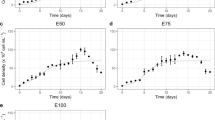Summary
The cultivation of photosynthetic microorganisms such as the microalga Spirulina platensis can provide an alternative source of food. The water in Mangueira Lagoon (Rio Grande do Sul state, southern Brazil) has several required nutrients for the growth of Spirulina and could be added to culture medium to reduce the cost of producing S. platensis. Although little studied, repeated batch cultivation is a very useful technique because it has a better cost–benefit ratio than other cultivation methods. In a series of runs, we studied the influence of cell concentration, renewal rate and strain on the specific growth rate and biomass productivity of S. platensis during repeated batch cultivation, the runs taking place in 2-l Erlenmeyer flasks for 2160 h at 30 °C and a light intensity of 2500 lux under a 12 h photoperiod. The three factors studied had a significant (P < 0.05) effect on the results (specific growth rate and productivity). Using Zarrouk’s medium, the highest specific growth rate (μX) was 0.111 day−1 while the biomass productivity (P X) was 0.0423 g l−1 day−1, while Mangueira Lagoon water supplemented with 10% Zarrouk’s medium gave μX = 0.113 day−1 and a productivity P X = 0.0467 g l−1 day−1. These values were two to three times higher than the results obtained in batch cultivation, indicating that the repeated batch cultivation of S. platensis is attractive and convenient.
Similar content being viewed by others
References
Belay A., Ota Y., Miyakawa K., Shimamatsu H., 1993 Current knowledge on potential health benefits of SpirulinaJournal of Applied Phycology 5: 2352–41
Box G.E.P., Hunter W.G., Hunter J.S., 1978 Statistics for Experimenters. An Introduction to Design, Data Analysis, and Model Building. New York: John Wiley & Sons, 0-471-09315-7
Bu’Lock J., Kristiansen B., 1991 Biotecnologia básica. Zaragoza: Editorial Acribia, 842-000-704-8
Costa J.A.V., Colla L.M., Duarte Filho P., Kabke K., Weber A., 2002 Modelling of Spirulina platensis growth in fresh water using response surface methodology World Journal of Microbiology and Biotechnology 18: 603–607
Costa J.A.V., Linde G.A., Atala D.I.P., Mibielli G.M., Krüger R.T., 2000 Modelling of growth conditions for cyanobacterium Spirulina platensis in microcosms World Journal of Microbiology and Biotechnology 16: 15–18
Duarte Filho, P., Silva, P., Costa, J.A.V., 2002 Estudo do crescimento de duas cepas de Spirulina platensis em diferentes meios de cultivo e níveis de agitação. In: Anais do XVIII CBCTA, Porto Alegre, Brasil
Estrada J.E.P., Bescós P.B., Fresno A.M.V., 2001 Antioxidant activity of different fractions of Spirulina platensis protean extract Il Farmaco 56: 497–500
Fábregas J., Otero A., Maseda A., Domínguez A., 2001 Two-stage cultures for the production of astaxanthin from Haematococcus pluvialisJournal of Biotechnology 89:65–71
Fábregas J., Patiño M., Arredondo-Vega B.O., Tobar J.L., Otero A., 1995a Renewal rate and nutrient concentration as tools to modify productivity and biochemical composition of cyclostat cultures of the marine microalga Dunaliella tertiolectaApplied Microbiology and Biotechnology 44:2872–2892
Fábregas J., Patiño M., Morales E.D., Cordero B., Otero A., 1996a Optimal renewal rate and nutrient concentration for the production of the marine microalga Phaeodactylum tricornutum in semicontinuous cultures Applied and Environmental Microbiology 62:2662–2668
Fábregas J., Patiño M., Morales E.D., Dominguez A., Otero A., 1996b Distinctive control of metabolic pahways by Chlorella autotrophica in semicontinuous culture Canadian Journal of Microbiology 42:1087–1090
Fábregas J., Patiño M., Vecino E., Cházaro F., Otero A., 1995b Productivity and biochemical composition of cyclostat cultures of the marine microalga Tetraselmis suecicaApplied Microbiology and Biotechnology 43:617–621
Fischer U., Santore U.J., Hüsemann W., Barz W., Alfermann A.W., 1994 Semicontinuous cultivation of photoautotrophic cell suspension cultures in a 20 L airlift-reactor Plant Cell, Tissue and Organ Culture 38:123–134
Gitelson A., Qiuang H., Richmond A., 1996 Photic volume in photobioreactors supporting ultrahigh population densities of the photoautotroph Spirulina platensisApplied and Environmental Microbiology 62:1570–1573
Henrikson R., 1994 Microalga Spirulina. Superalimento del futuro. Barcelona: Ediciones S.A. Urano, 84-7953-0472
Hirata S., Taya M., Tone S., 1998 Continuous cultures of Spirulina platensis under photoautotrophic conditions with change in light intensityJournal of Chemical Engineering of Japan 31:636–639
Otero A., Domínguez A., Lamela T., García D., Fábregas J., 1998 Steady-states of semicontinuous cultures of a marine diatom: Effect of saturating nutrient concentrations Journal of Experimental Marine Biology and Ecology 227:233–234
Otero A., Fábregas J., 1997 Changes in the nutrient composition of Tetraselmis suecica cultured semicontinuously with different nutrient concentrations and renewal rates Aquaculture 159:111–123
Qiang H., Guterman H., Richmond A., 1996 Physiological characteristics of Spirulina platensis (cyanobacteria) cultured at ultrahigh cell densitiesJournal of Phycology 32:1066–1073
Ramamoorthy A., Premakumari S., 1996 Effect of supplementation of Spirulina on hypercholesterolemic patients Journal of Food Science and Technology 33:124–128
Richmond A., 1990 Handbook of Microalgal Mass Culture. Boston: CRC Press, 0-84933-240-0
Torres-Durán P.V., Miranda-Zamora R., Paredes-Carbajal M.C., Mascher D., Blé-Castillo J., Díaz-Zagoya J.C., Juárez-Oropeza M.A., 1999 Studies on the preventive effect of Spirulina maxima on fatty liver development induced by carbon tetrachloride, in the rat Journal of Ethnopharmacology 64:141–147
Travieso L., Hall D.O., Rao K.K., Benítez F., Sánchez E., Borja R., 2001 A helical tubular photobioreactor producing Spirulina in a semicontinuous mode International Biodeterioration and Biodegradation 47:151–155
Vonshak A., 1997 Spirulina platensis (Arthrospira). Physiology, Cell-biology and Biotechnology, London: Taylor & Francis. 0-7484-06743
Vonshak A., Abeliovich A., Boussiba S., Arad S., Richmond A., 1982 Production of Spirulina biomass: effects of environmental factors and population density Biomass 2:175–185
Zarrouk, C. 1966 Contribution à l’étude d’une cyanophycée. Influence de divers facteurs physiques et chimiques sur la croissance et photosynthese de Spirulina maxima Geitler. Ph.D. Thesis, University of Paris
Acknowledgements
The authors thank ZERI Brazil Foundation and the Brazilian agencies FAPERGS and CAPES for the financial help, which made this research possible.
Author information
Authors and Affiliations
Corresponding author
Rights and permissions
About this article
Cite this article
Reinehr, C.O., Costa, J.A.V. Repeated batch cultivation of the microalga Spirulina platensis . World J Microbiol Biotechnol 22, 937–943 (2006). https://doi.org/10.1007/s11274-006-9138-0
Received:
Accepted:
Published:
Issue Date:
DOI: https://doi.org/10.1007/s11274-006-9138-0




